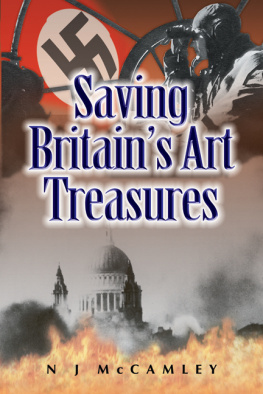THE STRANGE ODYSSEY OF POLANDS
NATIONAL TREASURES, 19391961
GORDON SWOGER
THE STRANGE ODYSSEY
OF POLANDS
NATIONAL TREASURES,
19391961
A Polish-Canadian Story
THE DUNDURN GROUP
TORONTO
Copyright Gordon Swoger, 2004
All rights reserved. No part of this publication may be reproduced, stored in a retrieval system, or transmitted in any form or by any means, electronic, mechanical, photocopying, recording, or otherwise (except for brief passages for purposes of review) without the prior permission of Dundurn Press. Permission to photocopy should be requested from Access Copyright.
Copy-Editor: Lloyd Davis
Design: Jennifer Scott and Andrew Roberts
Printer: University of Toronto Press
Library and Archives Canada Cataloguing in Publication
Swoger, Gordon
The strange odyssey of Poland's national treasures, 1939-1961 / Gordon Swoger.
ISBN 1-55002-515-5
1. Art Poland. 2. Art treasures in war Poland History 20th century. 3. World War, 19391945 Art and the war. 4. Cultural property Protection Poland History 20th century. I. Title.
N7255.P6S88 2004 940.53'1 C2004-905469-4
1 2 3 4 5 08 07 06 05 04
We acknowledge the support of the Canada Council for the Arts and the Ontario Arts Council for our publishing program. We also acknowledge the financial support of the Government of Canada through the Book Publishing Industry Development Program and The Association for the Export of Canadian Books, and the Government of Ontario through the Ontario Book Publishers Tax Credit program, and the Ontario Media Development Corporations Ontario Book Initiative.
Care has been taken to trace the ownership of copyright material used in this book. The author and the publisher welcome any information enabling them to rectify any references or credit in subsequent editions.
J. Kirk Howard, President
Printed and bound in Canada.
Printed on recycled paper.
www.dundurn.com
Dundurn Press
8 Market Street, Suite 200
Toronto, Ontario, Canada
M5E 1M6 | Gazelle Book Services Limited
White Cross Mills
Hightown, Lancaster, England
LA1 4X5 | Dundurn Press
2250 Military Road
Tonawanda NY
U.S.A. 14150 |
I would like to dedicate this book to my 3IB and 4IB History classes at Nicholas Copernicus High School in Warsaw, 199495, whose enthusiasm and interest got this Polish-Canadian connection off to a great start.
And to my wife, Barbara, and our children, who never doubted that the project would be carried through to a successful conclusion.
TABLE OF CONTENTS
Illustrations
Section 1: The Wawel Castle and the Polish Treasures Sent to Canada in 1940 (Colour)
Section 2: The Polish Treasures
Section 3: The Participants
MAPS
Map I Poland in 1939 / Escape Route
Map II Polands Frontiers over the Centuries: Poland in 1025
Map III Polands Frontiers over the Centuries: Poland in 1466
Map IV Polands Frontiers over the Centuries: Poland in 1939
Map V Polands Frontiers over the Centuries: Poland in 1945
Map VI Partitioning Poland 1772, 1792 and 1795
Map VII Europe and the Mediterranean, Route of the Treasures, 193940
Map VIII Eastern North America
These maps were prepared by Suzanne
Dodge and Associates Inc.
347 Centre Street, P.O. Box 1839
Prescott, Ontario, K0E 1T0
tel: 613-925-4665
email: ssdodge@sympatico.ca
Map I - Poland in 1939 / Escape Route
POLANDS FRONTIERS OVER THE CENTURIES
Map II - Poland 1025
Map III - Poland 1466
Poland and Lithuania were united under one ruler in 1386.
Map VI - Partitioning Poland
Map VII - Europe and the Mediterranean, Route of the Treasures 1939-40
Map VIII - Eastern North America
CHAPTER ONE
The Storm Clouds Gather
Concern for the royal treasures of the Wawel Castle, Cracow, mounted during the early months of 1939 as Poland faced the threat of Nazi invasion. Plans for the removal of the treasures to a place of safekeeping were finalized in March. Not all the castles valuable artifacts could be evacuated to a secure location, but the superintendent of the Wawel Castle was determined to protect the most ancient and valuable historical objects. Twenty special large metal trunks were ordered from a local tinsmith, together with seven long metal cylinders designed to hold the tapestries that graced the walls of the royal apartments and assembly rooms in the castle.
Why the concern about Cracow when Warsaw was the capital of the Republic of Poland? Why were so many valuable national treasures to be found on Wawel Hill in the southern city of Cracow? Actually, Cracow had served as the capital of the Kingdom of Poland almost from its inception, retaining that honour for more than five hundred years. During the Middle Ages and on through the Renaissance, the fortified Wawel Hill on the bank of the Vistula River served as the royal residence and administrative centre of the Polish kingdom. From their base in Cracow in the fifteenth and sixteenth centuries the Jagiellonian kings ruled the largest state in Europe; Poland stretched from the Baltic in the north to the Black Sea in the south, from Poznan in the west to a frontier close to Moscow and the Crimean peninsula in the east.
The Polish Commonwealth of this time was one of the most progressive states in Europe.
Nor did the Polish Commonwealth neglect intellectual pursuits. The University of Cracow was the second to be founded in central Europe (preceded only by the Charles University in Prague). This university became renowned for its high standard of scholarship, attracting such students as Nicolas Copernicus, who later went on to formulate his heliocentric model of the universe. The first Polish printing press was established in Cracow in 1473, three years before William Caxton set up the first English press in London.




















